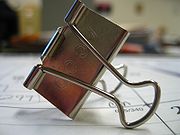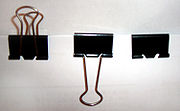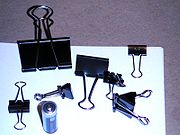
Binder clip
Encyclopedia

Staple (fastener)
A staple is a type of two-pronged fastener, usually metal, used for joining or binding materials together. Large staples might be used with a hammer or staple gun for masonry, roofing, corrugated boxes and other heavy-duty uses...
. The term bulldog clip
Bulldog clip
A bulldog clip is a device for temporarily binding sheets of paper together. It consists of a rectangular sheet of springy steel curved into a cylinder, with two flat steel strips inserted to form combined handles and jaws. The user presses the two handles together, causing the jaws to open against...
is used in the United Kingdom to describe both this invention and an older device with the same function, which is stronger and has rigid rather than folding handles. It is also sometimes referred to as a "handbag clip" because, when not in use, its clip can be up to look like a handbag.
Characteristics and methods of use


Spring steel
Spring steel is a low alloy, medium carbon steel or high carbon steel with a very high yield strength. This allows objects made of spring steel to return to their original shape despite significant bending or twisting.-Grades:...
bent into the shape of an isosceles triangle with loops at the apex. Tension along the base of the triangle forces the two sides closed, and the loops prevent the sharp steel edges from cutting into the paper. The loops also serve to hold two pieces of stiff wire
Wire
A wire is a single, usually cylindrical, flexible strand or rod of metal. Wires are used to bear mechanical loads and to carry electricity and telecommunications signals. Wire is commonly formed by drawing the metal through a hole in a die or draw plate. Standard sizes are determined by various...
, which are used as handles and allow the clip to be opened. The two slots cut in each loop are shaped so that the wire handles can be folded down once the clip has been attached, and the spring force of the wire holds them down on the surface of the paper. This holds the clip relatively flat, for easier stacking of paper. One handle can also be folded down while the other remains ups to allow the stack of papers to be hung up. The handles can also be removed altogether by squeezing them sideways and pulling them out, allowing for more permanent binding. As compared to a paper clip
Paper Clip
"Paper Clip" is a 1995 episode of The X-Files television series. It was the second episode broadcast in the show's third season. Paper Clip concludes the story regarding the agents' possession of a digital tape containing government secrets on extraterrestrials.- Plot :Continuing from the previous...
, the binder clip is able to bind sheets of paper more securely, and is also resistant to rust.
There are several sizes of binder clips, ranging from a base size of 5 millimetres (0.2 in) to 50 mm (1.97 in). The sheet steel portion is customarily black oxide
Black oxide
Black oxide or blackening is a conversion coating for ferrous materials, copper and copper based alloys, zinc, powdered metals, and silver solder. It is used to add mild corrosion resistance and for appearance. To achieve maximum corrosion resistance the black oxide must be impregnated with oil or...
coated, but a variety of decorative painted color schemes are also available. The sheet steel portion is occasionally made of stainless steel, the more typical spring steel can also be finished in nickel, silver or gold. The handles are normally nickel plated.
Uses
The binder clip is in common use in the modern office. It can hold a few to many sheets of paper, and is usually used in place of the paper clip for large volumes of paper. Various practical (and sometimes whimsical) alternative uses have been proposed. These include holding pieces of quilt together, creating a "beer pyramid" in a refrigerator with wire shelves, serving as a bookmark, or preventing computer cables from slipping behind desks. Smaller sized clips have been commonly used as "quick fix" fitting and sizing solutions in the fashion industry.History
The binder clip was invented in 1910 by Washington, D.C. resident Louis E. Baltzley, who was granted U.S. Patent Number 1,139,627 for his invention in 1915. At that time, the method of binding sheets of paper together was to punch holes in them and sew them together, making it tedious to remove a single sheet of paper.Baltzley invented the binder clip to help his father, Edwin Baltzley, a writer and inventor, hold his manuscripts together easily. While the original design has since been changed five times, the basic mechanism has remained the same.
Baltzley initially produced his invention through the L.E.B. Manufacturing Company. These earliest binder clips are stamped 'L.E.B.' on one side of the sheet steel. Manufacturing rights were later licensed to other companies.

